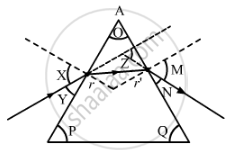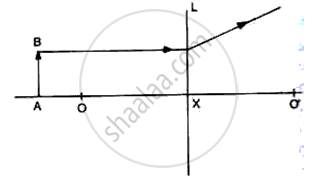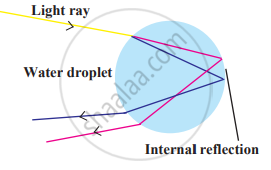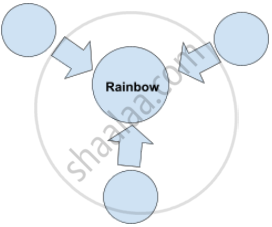Advertisements
Advertisements
Question
Describe an activity to show that colours of white light splitted by a glass prism can be recombined to get white light by another identical glass prism. Also draw ray diagram to show the recombination of the spectrum of white light.
Solution
The seven colours of a spectrum can be recombined to give back white light as
- Two identical glass prisms are placed such that their refracting surfaces are in opposite direction (placed inverted). When a beam of light is allowed to fall on the surface of one prism, a patch of ordinary white light is obtained on a screen placed behind the second prism.
- The first prism disperses the white light into seven coloured rays. The second prism receives all the seven coloured rays from the first prism and recombines them into original white light. This is because the refraction produced by the second prism is equal and opposite to that produced by the first prism. Hence, the light coming out of the second prism will be white

RELATED QUESTIONS
The path of a ray of light passing through a glass prism is shown below:

In this diagram, the angle of prism, angle of incidence, angle of emergence and angle of deviation, respectively, have been represented by:
(A) O, Y, Z and N,
(B) P, Y, M and Z,
(C) O, X, M and Z,
(D) P, X, Z and N.
In the figure given alongside, a narrow beam of white light is shown to pass through a triangular glass prism. After passing through the prism, it produces a spectrum YX on the screen.
Why do different colours of white light bend through different angles with respect to the incident beam of light?
What do you understand by the term spectrum? Name the various colours present in the spectrum of sunlight.
When a white light ray falls on a prism, the ray at its first surface suffers ______.
In an experiment to trace the path of a ray of light through a triangular glass prism, a student would observe that the emergent ray
(a) is parallel to the incident ray.
(b) is along the same direction of incident ray.
(c) gets deviated and bends towards the thinner part of the prism.
(d) gets deviated and bends towards the thicker part (base) of the prism.
Refer to fig
(i) Name the lens L.
(ii) What are the points O, O' called?
(iii) Complete the diagram to form the image of the object AB.
(iv) Write three characteristics of the image.

Write an Explanation.
Critical angle
Rainbow is a beautiful natural phenomenon. It is the combined effect of a natural three processes together produced by light. Write it into the circle.


When white light enters a glass prism from the air, the angle of deviation is least for ____________.
The splitting of white light into its component colours is called ____________.
